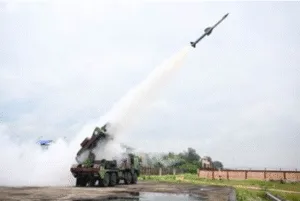Integrated Air Defence Weapon System Makes India Stronger
Newz Daddy Defence Updates
DRDO’s Integrated Air Defence Weapon System is A Multi-Layered Sky Guard that Covers All Heights And Distances
At around 12:30 p.m. on August 23, 2025, the Defence Research and Development Organisation (DRDO) successfully completed the Integrated Air Defence Weapon System (IADWS) first flight tests off the coast of Odisha. All-native Quick Reaction Surface to Air Missiles (QRSAM), Advanced Very Short Range Air Defence System (VSHORADS) missiles, and a high-power laser-based Directed Energy Weapon (DEW) make up the multi-layered IADWS air defence system.

Because the Integrated Air Defence Weapon System was entirely planned and constructed in India, in keeping with the ideal of Atmanirbhar Bharat, or self-reliant India, this achievement represents a significant milestone for the nation. This type of system integrates many weapons into a single shield, allowing for varying degrees of destruction of hostile drones, missiles, and planes. The VSHORADS is effective against fast and close targets, the QRSAM defends against short-range threats, and the high-power laser gives India a competitive edge by instantly destroying drones and other small aerial devices. It is more difficult for anything hostile to infiltrate the nation’s airspace with this type of multi-layered system.
As the program’s nodal laboratory, the Defence Research & Development Laboratory created a Centralised Command and Control Centre that oversees the integrated operation of every weapon system component. The Research Centre Imarat and the Centre for High Energy Systems and Sciences are responsible for developing VSHORADS and DEW, respectively.
The central command and control centre functions as the shield’s brain. It enables the lasers, missiles, and radars to function as a single unit. The VSHORADS system was developed by the Hyderabad-based Research Centre Imarat (RCI). It can destroy warplanes, drones, and helicopters that are flying at low altitudes. One of the most cutting-edge technologies in contemporary defence is the laser, a Directed Energy Weapon developed by the Centre for High Energy Systems and Sciences (CHESS). These labs, which are a component of DRDO, demonstrate how many Indian teams collaborated to accomplish this.
Three distinct targets—two fast-moving fixed-wing UAV targets and a multicopter drone—were engaged and totally destroyed by the QRSAM, VSHORADS, and High Energy Laser armament systems at various distances and elevations throughout the flight tests. Range instruments set up by Integrated Test Range, Chandipur, to record the flight data verified that every component of the weapon system—including the missile systems, drone detection and destruction system, weapon system command & control, communication, and radars—performed flawlessly. Senior DRDO experts and personnel from the Armed Forces observed the test.
There was more to this test than just launching rockets. Coordination was the key. Simultaneously, one multi-copter drone and two swift drone-like aircraft were destroyed. One was handled by QRSAM, another by VSHORADS, and the third was destroyed by the laser. By working together, this demonstrates that the Integrated Air Defence Weapon System is capable of handling a wide range of threats in actual combat. To ensure that every shot was on target, the Chandipur Integrated Test Range included radars, cameras, and tracking systems. It was a proud moment for the teams who toiled for years to make this happen, and senior scientists and defence personnel watched it live.
Mantri Raksha For the successful development of IADWS, Shri Rajnath Singh commended the industry, the armed forces, and DRDO. According to him, these special flight tests have demonstrated the nation’s multi-layered air defence capability and would fortify area security for critical sites against aerial threats from the adversary.
Rajnath Singh, the minister of defence, praised the exam, highlighting its importance. In the present era, when several nations utilise drones and missiles to protect important bases, industries, and cities is essential. India has demonstrated its ability to defend its own airspace independently of imports by demonstrating the Integrated Air Defence Weapon System. This enhances India’s standing as a country capable of designing, constructing, and managing its own advanced defence systems.
Dr. Samir V. Kamat, the chairman of DRDO and secretary of the Department of Defence R&D, has congratulated all the teams that participated in the successful flight tests.
The head of DRDO, Dr. Samir V. Kamat, commended the military, engineers, and scientists on their efforts. He referred to this accomplishment as an illustration of what India can accomplish when working together. There is more to the Integrated Air Defence Weapon System than meets the eye. It is a representation of India’s capacity to develop cutting-edge solutions using its own resources, workforce, and expertise.
A new chapter in India’s defence history has begun with the successful flight tests of the Integrated Air Defence Weapon System. With its advanced lasers and short-range missiles, the system demonstrates how India is advancing to safeguard its skies. India is not only strengthening its defences but also boosting the confidence of its scientists and soldiers with every test. The accomplishment at Chandipur sends a strong message: India is prepared to use its own strength to protect its airspace.
Also Read:
India Builds Stronger Defence Through Self-Reliance Journey
Army Leads With Organ Donation Initiative In The Armed Forces






